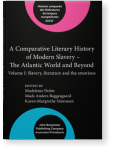Chapter 10
Orientalism, slavery and emotion
Slave market scenes in early nineteenth-century journeys to the Orient
The oriental travel narratives of the first half of the nineteenth century played an important
role in debates about slavery. An episode in the slave market of Constantinople that appeared in Alphonse de
Lamartine’s Voyage en Orient (1835) created a model followed by later writers. But while Lamartine, a
committed abolitionist, tried to stir up feelings of pity by describing the sale of a black woman and her child, in
Marcellus, Nerval and Pückler-Muskau, similar descriptions evoked different reactions, ranging from the condemnation
of Islamic polygamy to the acceptance of slavery as an ‘oriental fatality.’ Nerval, for his part, reserved pity for
the fate of white slaves. Oriental travel narratives as such represent a kind of emotional barometer that gauges both
the progress of abolitionist discourse and resistance to it.
This content is being prepared for publication; it may be subject to changes.
